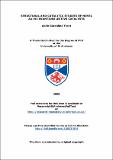Files in this item
Structural and catalytic studies of novel Au/Ni enantioselective catalysts
Item metadata
| dc.contributor.advisor | Baddeley, Christopher J. | |
| dc.contributor.author | Trant, Aoife Geraldine | |
| dc.coverage.spatial | xiv, 249 | en_US |
| dc.date.accessioned | 2010-02-02T16:45:47Z | |
| dc.date.available | 2010-02-02T16:45:47Z | |
| dc.date.issued | 2008 | |
| dc.identifier | uk.bl.ethos.552337 | |
| dc.identifier.uri | https://hdl.handle.net/10023/854 | |
| dc.description.abstract | Heterogeneous enantioselective catalysis strives to create new successful catalysts. One of the most researched examples is the hydrogenation β-ketoesters using nickel-based catalysts. A hindrance in the industrial scale-up of this enantioselective hydrogenation reaction is the lack of exact details of how chirality is bestowed onto this achiral metal surface. While a number of mechanisms have been proposed to explain the enantioselective behaviour of this system, these are predominantly based on catalytic studies. An alternative approach is through surface science studies examining the morphology, structure and composition of this catalytic system. A range of ultrahigh vacuum based model studies investigating the structure and composition of ultrathin Ni films and Ni/Au surface alloys on Au{111} using the techniques of Scanning Tunnelling Microscopy (STM) and Medium Energy Ion Scattering (MEIS) are presented in this thesis. In addition, the adsorption of the chiral modifier (S)-glutamic acid has been studied on these surfaces using vibrational spectroscopy (Reflection Absorption Infrared Spectroscopy (RAIRS)) and Temperature Programmed Desorption (TPD). Furthermore, MEIS has been used to investigate the influence of (S)-glutamic acid on the surface composition of Au/Ni model catalysts detecting effects such as adsorbate induced segregation and de-alloying behaviour. In addition, colloidal preparative routes have been used to synthesise bimetallic Au/Ni nanoparticles supported on mesoporous silica. The catalysts are then modified by the adsorption of the chiral ligand, (R,R)-tartaric acid. Finally, the catalysts are tested for their activity and enantioselectivity with respect to methylacetoacetate hydrogenation. At each stage the catalysts are characterised by a combination of Extended X-ray Absorption Fine Structure (EXAFS); Transmission Electron Microscopy (TEM), Energy Dispersive X-ray Spectrometry (EDS) and Atomic Absorption Spectroscopy (AAS). | en_US |
| dc.language.iso | en | en_US |
| dc.publisher | University of St Andrews | |
| dc.subject.lcc | QD505.T8 | |
| dc.subject.lcsh | Enantioselective catalysis | en |
| dc.subject.lcsh | Gold alloys | en |
| dc.subject.lcsh | Nickel catalysts | en |
| dc.subject.lcsh | Catalysts | en |
| dc.title | Structural and catalytic studies of novel Au/Ni enantioselective catalysts | en_US |
| dc.type | Thesis | en_US |
| dc.type.qualificationlevel | Doctoral | en_US |
| dc.type.qualificationname | PhD Doctor of Philosophy | en_US |
| dc.publisher.institution | The University of St Andrews | en_US |
This item appears in the following Collection(s)
Items in the St Andrews Research Repository are protected by copyright, with all rights reserved, unless otherwise indicated.

